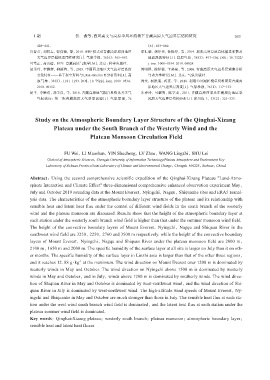Page 205 - 《高原气象》2022年第1期
P. 205
1 期 伏 薇等:西风南支与高原季风环流场下青藏高原大气边界层结构研究 203
428-441. (6):833-860.
许鲁君,刘辉志,徐祥德,等,2018. WRF模式对青藏高原那曲地区 郑汇璇,胡泽勇,孙根厚,等,2019. 那曲高寒草地总体输送系数及
大气边界层模拟适用性研究[J]. 气象学报,76(6):955-967. 地面热源特征[J]. 高原气象,38(3):497-506. DOI:10. 7522/
叶笃正,高由禧,1979. 青藏高原气象学[M]. 北京:科学出版社. j. issn. 1000-0534. 2019. 00024.
赵采玲,李耀辉,柳媛普,等,2019. 中国西北地区大气边界层高度 周明煜,徐祥德,卞林根,等,2000. 青藏高原大气边界层观测分析
变化特征——基于探空资料与ERA-Interim再分析资料[J]. 高 与动力学研究[M]. 北京:气象出版社.
原气象,38(6):1181-1193. DOI:10. 7522/j. issn. 1000-0534. 周文,杨胜朋,蒋熹,等,2018. 利用 COSMIC掩星资料研究青藏高
2018. 00152. 原地区大气边界层高度[J]. 气象学报,76(1):117-133.
赵平,李跃清,郭学良,等,2018. 青藏高原地气耦合系统及其天气 朱春玲,马耀明,陈学龙,2011. 青藏高原西部及东南周边地区季
气候效应:第三次青藏高原大气科学试验[J]. 气象学报,76 风前大气边界层结构分析[J]. 冰川冻土,33(2):325-333.
Study on the Atmospheric Boundary Layer Structure of the Qinghai-Xizang
Plateau under the South Branch of the Westerly Wind and the
Plateau Monsoon Circulation Field
FU Wei,LI Maoshan,YIN Shucheng,LV Zhao,WANG Lingzhi,SHU Lei
(School of Atmospheric Sciences,Chengdu University of Information Technology/Plateau Atmosphere and Environment Key
Laboratory of Sichuan Province/Joint Laboratory of Climate and Environmental Change,Chengdu 610225,Sichuan,China)
Abstract:Using the second comprehensive scientific expedition of the Qinghai-Xizang Plateau "Land-Atmo‐
sphere Interaction and Climate Effect" three-dimensional comprehensive enhanced observation experiment May,
July and October 2019 sounding data at the Mount Everest,Nyingchi,Nagqu,Shiquanhe sites and ERA5 reanal‐
ysis data. The characteristics of the atmospheric boundary layer structure of the plateau and its relationship with
sensible heat and latent heat flux under the control of different wind fields in the south branch of the westerly
wind and the plateau monsoon are discussed. Results show that the height of the atmospheric boundary layer at
each station under the westerly south branch wind field is higher than that under the summer monsoon wind field.
The height of the convective boundary layers of Mount Everest,Nyingchi,Nagqu and Shiquan River in the
southwest wind field are 3250,2250,2760 and 3500 m respectively. while the height of the convective boundary
layers of Mount Everest,Nyingchi,Nagqu and Shiquan River under the plateau monsoon field are 2000 m,
2100 m,1650 m and 2000 m. The specific humidity of the surface layer at all site is larger on July than it on oth‐
er months. The specific humidity of the surface layer in Linzhi area is larger than that of the other three regions,
and it reaches 12. 88 g·kg at the maximum. The wind direction on Mount Everest over 1200 m is dominated by
-1
westerly winds in May and October. The wind direction on Nyingchi above 1500 m is dominated by westerly
winds in May and October,and in July,winds above 1200 m is dominated by southerly winds. The wind direc‐
tion of Shiquan River in May and October is dominated by west-southwest wind,and the wind direction of Shi‐
quan River in July is dominated by west-northwest wind. The high-altitude wind speeds of Mount Everest,Ny‐
ingchi and Shiquanhe in May and October are much stronger than those in July. The sensible heat flux at each sta‐
tion under the west wind south branch wind field is dominated,and the latent heat flux at each station under the
plateau summer wind field is dominated.
Key words:Qinghai-Xizang plateau;westerly south branch;plateau monsoon;atmospheric boundary layer;
sensible heat and latent heat fluxes

